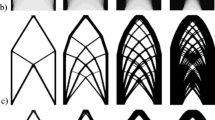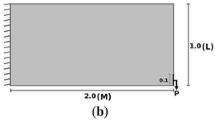Abstract
The details of the Theorem of Michell are examined. Some remarks are made about the quantity of structure and the Maxwell number of a framework and about the Michell optimality criterion. The two-loads bending problem is examined, comparing solutions derived from another one found by Sokół and Lewiński (Struct Multidisc Optim 42:835–853, 2010) with others obtained from simulated annealing (SA) search. The collected data suggest that the Michell theorem is a sufficient test for a framework to be optimal, but maybe no necessary. As a consequence, there could exist problems for which the theorem is useless.



Similar content being viewed by others
Notes
We find minor mistakes in the Table 1 of Sokółand Lewiński (2010): x D/d and y D/d must be x D/L and y D/L accordingly with the proportions in the Fig. 20 of the paper. The SA search confirms the authors’ layout and cost, although the best result obtained by SA was of \({\cal{Q}}/(4PL) =0.953814 \), with an error of up to 1.2% respect to the analytical result of the authors.
The complete geometry and connectivity definition of the SA solutions—and others benchmarks structures— can be downloaded from the page http://habitat.aq.upm.es/gi/mve/dt/.
\({\cal{Q}}\) is reduced by \(\alpha=\sqrt{({\cal{Q}}^{\perp}-\Delta {\cal{Q}}^{\perp})/{\cal{Q}}^{\|}}\), where \({\cal{Q}}^{\perp}\) accounts for the horizontal part of \({\cal{Q}} = |{q}_{i}|\ell_{i}\), as \({\cal{Q}}^{\|}\) does for the vertical one, being \(\Delta {\cal{Q}}^{\perp}\) the horizontal part cancelled removing members. Note that this reductions is obtained with new y coordinates: y new = αy.
References
Cervera Bravo J (1989) Tres teoremas fundamentales de la teoría del diseño de estructuras. Inf Constr 40(399):57–66. Available online in http://oa.upm.es/3828/
Cervera Bravo J (2008) Concebir y analizar estructuras. Universidad Politécnica de Madrid. Available online in http://oa.upm.es/189/
Culmann K (1866) Die graphische Statik. s.d., Zürich
Maxwell JC (1890) Scientific papers II. Cambridge University Press
Michell AGM (1904) The limits of economy of material in frame-structures. Philos Mag S.6, 8(47):589–597
Rozvany GIN (2011) On symmetry and non-uniqueness in exact topology optimization. Struct Multidisc Optim 43:297–317
SokółT, Lewiński T (2010) On the solution of the three forces problem and its application in optimal designing of a class of symmetric plane frameworks of least weight. Struct Multidisc Optim 42:835–853
Vàzquez Espí C, Vàzquez Espí M (1997) Sizing, shape, and topology design optimization of trusses using genetic Algorithm—discussion. J Struct Eng 123:375–376
Vàzquez Espí M (1994) El recocido simulado: un nuevo algoritmo para la optimación de estructuras (PhD). Universidad Politécnica de Madrid, Madrid. Available online in http://oa.upm.es/968/
Vázquez Espí M (1995) Un nuevo algoritmo para la optimación de estructuras: el recocido simulado. Informes de la Construcción 46(436):49–69 doi:10.3989/ic.1995.v46.i436.1084
Acknowledgments
The writers are indebted with Prof. Jesús Ortiz (Madrid) for his enlightening in the subtle concepts under the field T. They also thank Blanca Estevan, María Cifuentes, Carlos Vázquez, Pilar Vázquez and Elena Moreno, who made a carefully reading and reviewing of the English expression of their ideas. The present paper was prepared within the one-year staying of Vázquez at CIMNE (Universidad Politécnica de Barcelona) under the surveillance of Dr. Eugenio Oñate, financed by the Universidad Politecnica de Madrid.
Author information
Authors and Affiliations
Corresponding author
Rights and permissions
About this article
Cite this article
Vázquez Espí, M., Cervera Bravo, J. On the solution of the three forces problem and its application in optimal designing of a class of symmetric plane frameworks of least weight. Struct Multidisc Optim 44, 723–727 (2011). https://doi.org/10.1007/s00158-011-0702-3
Received:
Revised:
Accepted:
Published:
Issue Date:
DOI: https://doi.org/10.1007/s00158-011-0702-3




